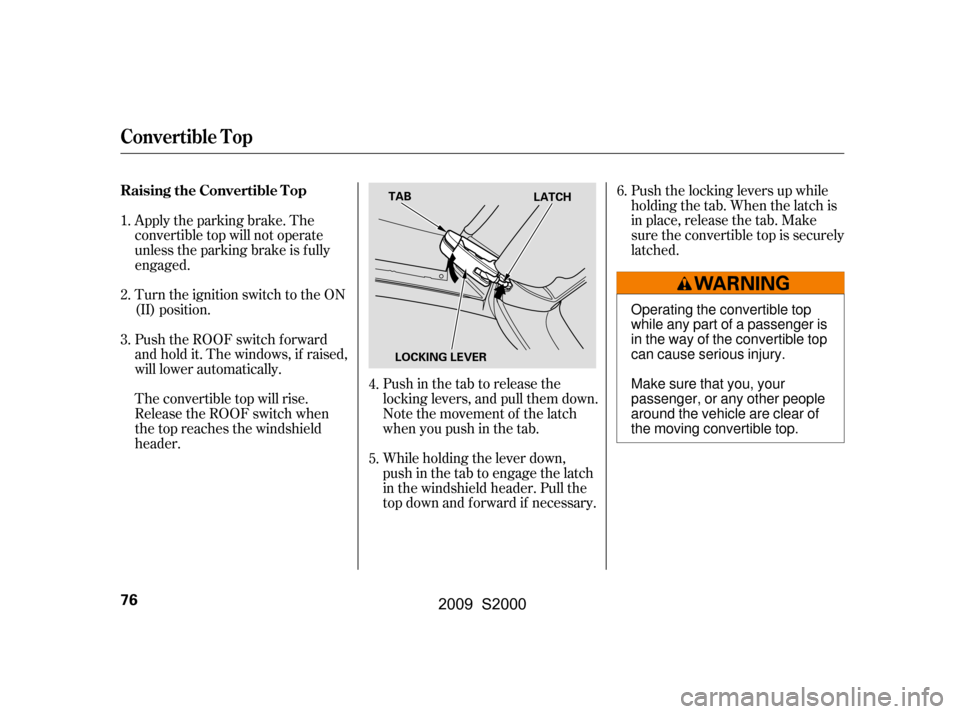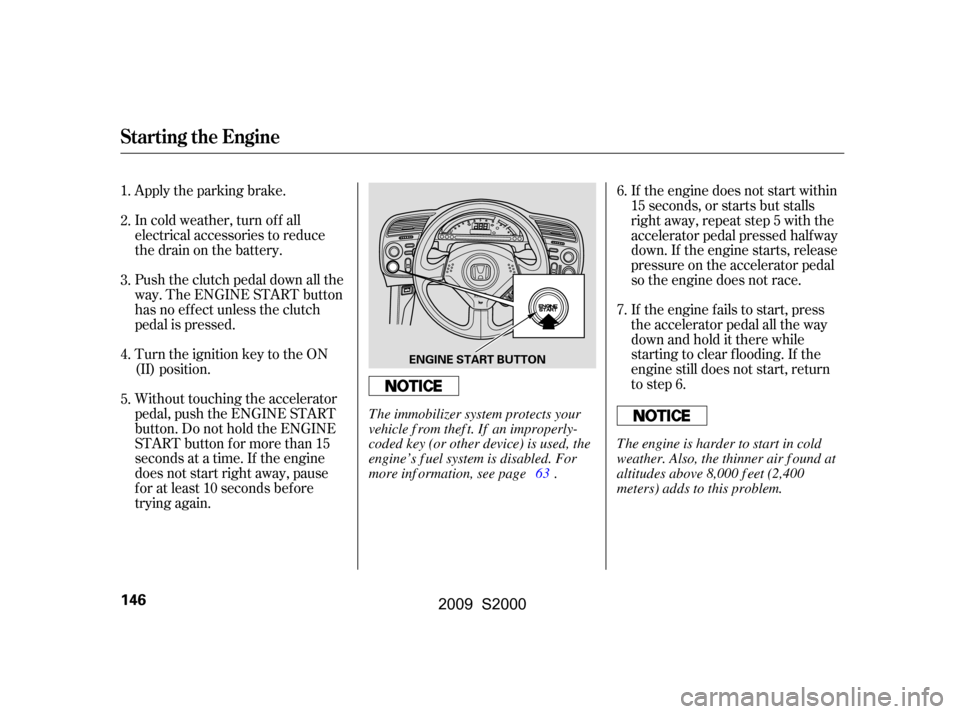Page 79 of 268

Push the locking levers up while
holding the tab. When the latch is
in place, release the tab. Make
sure the convertible top is securely
latched.
Push in the tab to release the
locking levers, and pull them down.
Note the movement of the latch
when you push in the tab.
While holding the lever down,
push in the tab to engage the latch
in the windshield header. Pull the
topdownandforwardif necessary.
Apply the parking brake. The
convertible top will not operate
unless the parking brake is f ully
engaged.
Turn the ignition switch to the ON
(II) position.
Push the ROOF switch f orward
and hold it. The windows, if raised,
will lower automatically.
The convertible top will rise.
Release the ROOF switch when
the top reaches the windshield
header.
5. 6.
4.
1.
2.
3.
Convertible Top
Raising the Convertible T op
76
TAB
LATCH
LOCKING LEVER
Operating the convertible top
while any part of a passenger is
in the way of the convertible top
can cause serious injury.
Make sure that you, your
passenger, or any other people
around the vehicle are clear of
the moving convertible top.
2009 S2000
Page 91 of 268
To apply the parking brake, pull the
lever up f ully. To release it, pull up
slightly, push the button, and lower
the lever. The parking brake
indicator on the instrument panel
should go out when the parking
brake is f ully released (see page ).46
Parking Brake
88
BUTTON
PARKING BRAKE LEVER
Driving the vehicle with the parking
brake applied can damage the rear
brakes and hubs. A beeper will sound if
the vehicle is driven with the parking
brake on.
2009 S2000
Page 133 of 268
Park the vehicle, and set the
parking brake. Pull the hood
release handle located under the
lower lef t corner of the dashboard.
The hood will pop up slightly.
Screw the fuel fill cap back on
until it clicks at least once. If you
do not properly tighten the cap,
the malf unction indicator lamp
maycomeon(seepage ).You
will also see a ‘‘CHECK FUEL
CAP’’ message on the inf ormation
display.
Push the f uel f ill door closed until
it latches.
Put your f ingers under the f ront
edge of the hood near the center.
Slide your hand to the lef t until
you f eel the hood latch handle.
Push this handle to the lef t to
release the hood. Lif t up the hood.
If the hood latch handle moves
stif f ly, or if you can open the hood
without lifting the handle, the
mechanism should be cleaned and
lubricated.
1.
2.
5.
6.
219
Service Station Procedures
Opening and Closing the Hood
130
RELEASE HANDLE
2009 S2000
Page 146 of 268
........................
Driving Guidelines .144
........................
Preparing to Drive .145
.......................
Starting the Engine .146
...................
Manual Transmission .147
...........................................
Parking .149
.............................
Braking System .149
...............
Anti-lock Brakes (ABS) .150
Vehicle Stability Assist (VSA
),
aka Electronic Stability Control .......................
(ESC), System .152
Tire Pressure Monitoring System ......................................
(TPMS) .154
...........................
Towing a Trailer .157
This section gives you tips on
starting the engine under various
conditions, and how to operate the
manual transmission. It also includes
important inf ormation on parking
your vehicle, the braking system, the
vehicle stability assist (VSA
)
system, the tire pressure monitoring
system (TPMS), and f acts you need
if you are planning to tow a trailer.
Driving
Driving
143
2009 S2000
Page 149 of 268

Apply the parking brake.
In cold weather, turn of f all
electrical accessories to reduce
the drain on the battery.
Push the clutch pedal down all the
way. The ENGINE START button
has no ef f ect unless the clutch
pedal is pressed.
Turn the ignition key to the ON
(II) position.
Without touching the accelerator
pedal, push the ENGINE START
button. Do not hold the ENGINE
START button for more than 15
seconds at a time. If the engine
does not start right away, pause
f or at least 10 seconds bef ore
trying again.If the engine fails to start, press
the accelerator pedal all the way
downandholdittherewhile
starting to clear flooding. If the
engine still does not start, return
to step 6.
If theenginedoesnotstartwithin
15 seconds, or starts but stalls
right away, repeat step 5 with the
accelerator pedal pressed halfway
down. If the engine starts, release
pressure on the accelerator pedal
so the engine does not race.
1.
2.
3.
4.
5. 6.
7.
Starting the Engine
146
ENGINE START BUTTON
The engine is harder to start in cold
weather. Also, the thinner air f ound at
altitudes above 8,000 f eet (2,400
meters) adds to this problem.
T he immobilizer system protects your
vehicle f rom thef t. If an improperly-
coded key (or other device) is used, the
engine’s f uel system is disabled. For
more inf ormation, see page .
63
2009 S2000
Page 152 of 268

Resting your f oot on the pedal keeps
the brakes applied lightly, builds up
heat, and reduces their ef f ectiveness
and reduces brake pad life. In
addition, f uel economy can be
reduced. It also keeps your brake
lights on all the time, conf using
drivers behind you.
Your vehicle is equipped with disc
brakes at all f our wheels. A power
assist helps reduce the ef f ort needed
on the brake pedal. The anti-lock
brake system (ABS) helps you retain
steering control when braking very
hard.
Always use the parking brake when
you park your vehicle. Make sure
the parking brake is set f irmly, or
your vehicle may roll if it is parked
on an incline.
Constant application of the brakes
when going down a long hill builds
up heat and reduces their ef f ective-
ness. Use the engine to assist the
brakes by taking your f oot of f the
accelerator and downshif ting to a
lower gear.
Make sure the convertible top and
the windows are closed.
Make sure the removable hardtop
is properly installed and the
windows are closed.
Make sure the parking brake is
f ully released bef ore driving away.
Driving with the parking brake
partially set can overheat or
damage the rear brakes.
If the vehicle is f acing downhill,
turn the front wheels toward the
curb, and put the transmission in
reverse gear.
If the vehicle is f acing uphill, turn
the front wheels away from the
curb, and put the transmission in
f irst gear.
Never park over dry leaves, tall
grass, or other f lammable materials. The hot three way
catalytic converter could cause
these materials to catch on fire.
Lock the doors.
Place any packages, valuables, etc.,
in the trunk or take them with you.
Turn of f the lights.
CONT INUED
Except CR models CR models
Parking
Parking T ips Braking System
Parking, Braking System
Driving
149
2009 S2000
Page 163 of 268

To eliminate potential hazards, read
the instructions bef ore you begin,
and make sure you have the tools
and skills required.
All service items not detailed in this
section should be perf ormed by a
certif ied technician or other qualif ied
mechanic.Make sure your vehicle is parked
on level ground, the parking brake
is set, and the engine is of f .
To clean parts, use a commercially
available degreaser or parts
cleaner, not gasoline.
To reduce the possibility of f ire or
explosion, keep cigarettes, sparks,
and flames away from the battery
and all f uel-related parts.
Wear eye protection and
protective clothing when working
with the battery or compressed air. Do
not run the engine unless
instructed to do so.
Some of the most important saf ety
precautions are given here.
However, we cannot warn you of
every conceivable hazard that can
arise in performing maintenance.
Only you can decide whether or
not you should perf orm a given
task.
Let the
engine and exhaust system cool
down bef ore touching any parts. Be sure
there is adequate ventilation
whenever you operate the
engine.
Maintenance Saf ety
Important Saf ety Precautions Injury f rom moving parts.
Burns f rom hot parts.
Carbon Monoxide poison
f rom engine exhaust.
Potential Vehicle Hazards
160
Failure to properly follow
maintenance instructions and
precautions can cause you to
be seriously hurt or killed.
Always follow the procedures
and precautions in this owner’s
manual.
Improperly maintaining this
vehicle, or failing to correct a
problem before driving can
cause a crash in which you can
be seriously hurt or killed.
Always follow the inspection
and maintenance
recommendations and
schedules in this owner’s
manual.
2009 S2000
Page 170 of 268

�µ
�Ì �µ�µ�µ
�µ
U.S. Vehicles:
Youshouldcheckthefollowing
items at the specif ied intervals. If
you are unsure of how to perf orm
any check, turn to the appropriate
page listed. Lights Check the operation of
the headlights, parking lights,
taillights, high-mount brake light,
and license plate lights monthly.
See page .
According to state and federal
regulations, f ailure to perf orm
maintenance on the items marked
with will not void your emissions
warranties. However, all
maintenance services should be
perf ormed in accordance with the
intervals indicated by the
inf ormation display. Tires Check the tire pressure
monthly. Examine the tread f or
wear and foreign objects. See page.
Brakes and clutch Check the
f luid level monthly. See page .
Engine coolant level Check the
radiator reserve tank every time
youfillthefueltank.Seepage.
Engine oil level Check every
time you fill the fuel tank. See
page.
131
132
178
189 179
CONT INUED
Maintenance, replacement, or
repair of emissions control
devices and systems may be done
by any automotive repair
establishment or individual using
parts that are ‘‘certif ied’’ to EPA
standards.
Owner’s Maintenance Checks
Maintenance Minder
Maint enance
167
2009 S2000